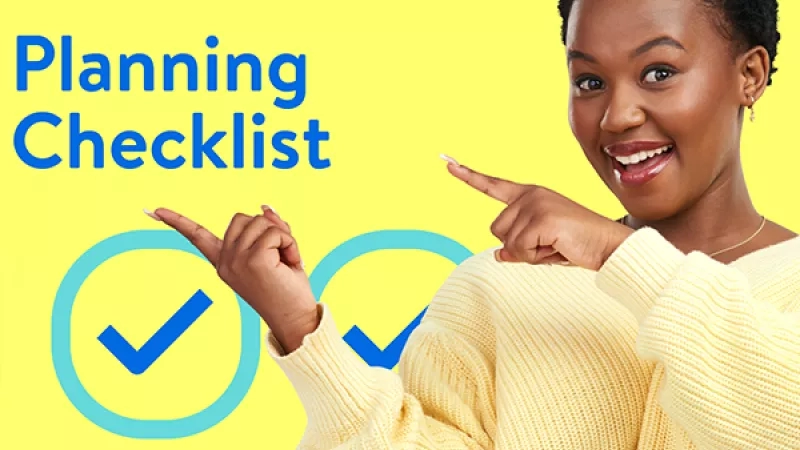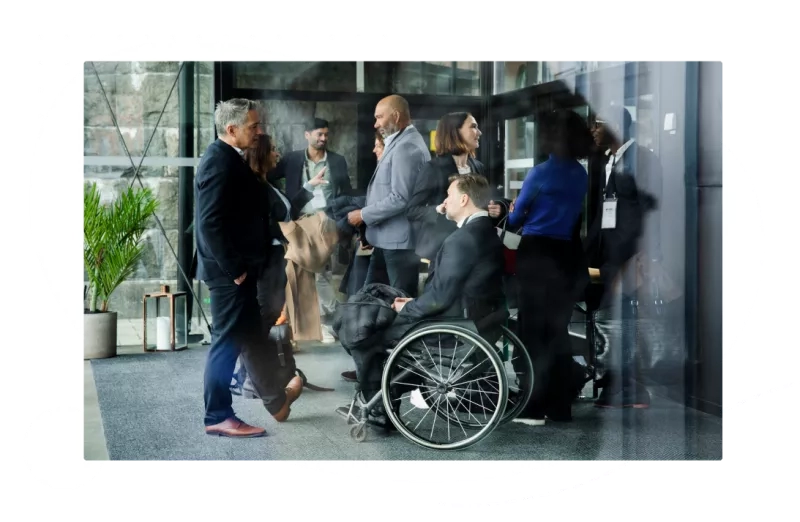When crafting an event itinerary, you’ll need to consider the experience of both your attendees and those involved in managing your event, including your event planning team, vendors, sponsors, exhibitors, and on-site staff.
This means that as a planner, you’re responsible for multiple event itineraries – a “back-end” itinerary for planning and management and a “front-end” itinerary created for attendees.
What Is an Event Itinerary?
As we’ll be looking at two different types of event itineraries, let’s get clear on the difference between the two.
An attendee event itinerary is used to inform event attendees of important agenda details like the event date(s), location, session and activity times, and scheduled transportation. On the other hand, an event itinerary for planners and staff contains scheduling details used to organize and execute the event, such as timelines for speakers and exhibitor setup times.
What Are the Essential Elements of an Event Itinerary?
Events can be huge revenue drivers, which is why it’s so critical to get them right. According to a recent study conducted by Research Dive, the global event industry is projected to generate $1,457.2 million in revenue by 2028, rising at a CAGR of 23.1% from 2021-2028.
As a planner, part of your job is undoubtedly to rake in as much revenue as possible with the help of your events. This means finding ways to boost your time management and operate more efficiently, cutting out as many uncertainties as possible by planning for everything, and making your event as enticing as possible to attendees.
The best way to do all of this? Crafting a detailed event itinerary. If done right, your itinerary can be a comprehensive guide to your event – a place for staff and attendees alike to have all (or most) of their questions answered.
Essential Elements of Event Management Itineraries
The essential elements of an event itinerary for those managing the event include an event schedule detailing the times, locations, and responsibilities for all vendors, venue staff, planning team staff, speakers, sponsors, and exhibitors.
In your event management itinerary, you’ll outline elements like:
- Content management details for speakers and presenters
- Event logistics instructions
- Event management roles and responsibilities
- Critical setup and timing details for vendors, exhibitors, and sponsors
- Equipment and supplies needed for each activity, session, etc.
- Travel information and accommodation details
Essential Elements of Attendee Itineraries
Your attendee itinerary will look much different than your behind-the-scenes itinerary. The essential elements of an event itinerary for attendees include an event agenda that’s easy to access, understand, and update so that if session times, locations, or speakers change, your attendees always know what to expect and where they need to be.
In your attendee itinerary, you’ll outline elements like:
- Critical scheduling information, such as check-in times, session agenda, etc.
- Local transportation and accommodation information
- Special activities during your event
- Details regarding accessibility
A great way to make your event calendar accessible and flexible is to leverage mobile event apps to give your attendees constant access to up-to-date itinerary details.
Event Itinerary Example
Want an event itinerary example before you start building out your own? Check out the event itinerary templates below to help you get started with an event management itinerary or an attendee itinerary.
Event Itinerary Template for Event Organizers, Vendors, and Participants
Use the event itinerary template below for those participating in bringing your events to life, including your planning team, vendors, venue staff, speakers, sponsors, and exhibitors.
EVENT NAME
Date(s) of Event:
Start and End Time of Event:
Venue:
Planning Team and Venue Staff:
- Contact information for all members of the planning team and POCs for venue staff, vendors, exhibitors, sponsors, and speakers
- Travel details, including information about traveling to your venue’s locality, accommodations, and local transportation
- Staff check-in time and location for each day
- Roles and responsibilities for each member of the team, including a detailed schedule of the time and location for each item
- Event setup and teardown times for staff, vendors, exhibitors, sponsors, etc.
- Equipment and supplies needed for each activity, session, etc.
- Load-in and load-out details, including access information, parking details, and rules and regulations
- Deadline to vacate event space
- Attendee event schedule, including high-traffic times and times when staff are free to attend sessions or other event activities
- Designated breaks and meal times
- Wi-Fi details, charging stations, and other tech-related information
Vendors:
- Contact information for planning team POC
- Check-in time and location
- Setup and teardown times and location, including deadline to vacate event space
- Equipment and supplies needed
- Load-in and load-out details, including access information, parking details, and rules and regulations
- Time windows for vendor to be actively working/engaging with attendees or event staff
- Attendee event schedule to anticipate high-traffic times and determine when vendor staff must be available
- Designated breaks and meal times
- Venue rules and regulations applicable to each vendor
- Dress code for vendors
- Wi-Fi details, charging stations, and other tech-related information
Exhibitors:
- Contact information for planning team POC
- Local transportation and accommodation suggestions, including any room block details
- Check-in time and location
- Booth number, accompanied by exhibitor floor plan to identify booth location
- Equipment and supplies needed
- Setup and teardown times and location, including deadline to vacate event space
- Rules and regulations such as booth size, signage, permitted materials, etc.
- Load-in and load-out details, including access information, parking details, and rules and regulations
- Exhibit floor open hours, including anticipated high-traffic times to ensure booths are appropriately staffed
- Attendee event schedule to anticipate low-traffic times and opportunities for participating in other event activities outside of the exhibit floor
- Designated breaks and meal times
- Promotional presence, including where and when exhibitors will be promoted during your event to help them capitalize on these opportunities
- Dress code for vendors
- Wi-Fi details, charging stations, and other tech-related information
Sponsors:
- Contact information for planning team POC
- Local transportation and accommodation suggestions
- Check-in time and location
- Booth number, accompanied by exhibitor floor plan to identify booth location
- Equipment and supplies needed
- Booth and setup and teardown times and locations, including deadline to vacate event space
- Sponsor promotional content setup and teardown times, locations, and guidelines
- Rules and regulations such as booth size, signage, permitted materials, sponsor content guidelines, etc.
- Load-in and load-out details, including access information, parking details, and rules and regulations
- Exhibit floor open hours, including anticipated high-traffic times to ensure booths are appropriately staffed
- Attendee event schedule to anticipate low-traffic times and opportunities for participating in other event activities outside of the exhibit floor
- Designated breaks and meal times
- Promotional presence, including where and when sponsors will be promoted during your event to help them capitalize on these opportunities
- Dress code for sponsors
- Wi-Fi details, charging stations, and other tech-related information
Speakers:
- Contact information for planning team POC
- Local transportation and accommodation suggestions, including any room block details, as well as flights or other travel details if your planning team is organizing speakers’ travel to your location
- Check-in time(s) and location(s) for each speaking engagement to conduct sound checks, prep speakers, etc.
- Speaking schedule, including start/end time, location, and topic for each speaking engagement
- Audio-visual details, including equipment that will be available for speakers during their presentations
- Presentation materials or other supplies needed
- Travel and accommodation information if arranged by the planning team
- Attendee event schedule, including opportunities for participating in other event activities outside of speaking engagements
- Designated breaks and meal times, if speakers will be present for more than a few hours
- Promotional opportunities, including where and when speakers will be promoted during your event to help them capitalize on opportunities such as interviews, book signings, etc.
- Regulations and guidelines speakers must follow, including time limits, content restrictions, etc.
- Dress code for speakers
- Wi-Fi details, charging stations, and other tech-related information
Event Itinerary Template for Attendees
Your attendees’ event itinerary must be clear and easy to follow and provide all the information attendees need to successfully navigate your event. The below event itinerary template includes all the details you should incorporate in your attendee itinerary.
EVENT NAME
Date(s) of Event:
Start and End Time of Event:
Venue:
Attendee Event Schedule:
- Your attendee itinerary should include a complete list of all available event activities, such as:
- Check-in and registration times and location
- Opening remarks and keynote speaker time, location, and description
- Session times, locations, and speakers
- Speaker bios and session descriptions so attendees know what to expect
- Exhibitor floor opening and closing times
- Networking and additional activities times and locations
- Special activities or add-ons available to select attendees
- Meal times and free periods
- Closing remarks/official event end
Need-to-Know Event Details:
- Room booking details for a room block or local options with convenient transportation to your venue
- Map of the venue, including a separate exhibitor floor map
- Contact details for an on-site representative or an information point for questions or assistance
- Wi-Fi details, charging stations, prohibited devices, and other tech-related information
- Transportation details, including shuttle services, parking information, local transportation options, etc.
- Sponsor and exhibitor details, including a list of all event sponsors and exhibitors (your attendee itinerary is a great place for promotion) and sponsored sessions or activities
- Venue accessibility information, including elevator access, ramp entrance locations, service animal guidance, sessions with closed captions or interpreters, etc.
- Dress code for attendees
- Local map or list of recommendations for meals, happy hours, and other activities outside of event hours
Smoother Planning and Execution with Event Technology
By now, you’re probably getting a feel for just how much work is involved in crafting an event itinerary. The best way to make things easier on yourself?
Event planner software! According to a study by Enterprise Event Marketing, using event technology can increase attendance by 20% and productivity by 27%.
Now, this study was conducted in 2016, and event tech has only gotten more sophisticated, more customizable, and more robust since then, which means the positive impact of event tech has been growing in kind.
Not sure where to start with event technology or which solutions might work best for you? Here are just a few pieces of event tech that can help you throughout the planning process, including building your event itineraries:
- Event management software to help you manage the entire event planning, execution, and evaluation process
- Event marketing technology to manage all your event marketing efforts
- Content management software to help you communicate and collaborate with your event partners
- Event budget management software for all your event budgeting needs, from tracking expenses to proving ROI
- Mobile event apps to host all your event details, including your full attendee itinerary
Want a comprehensive list of the event tech available to planners today? Check out this blog post about event technology trends!













